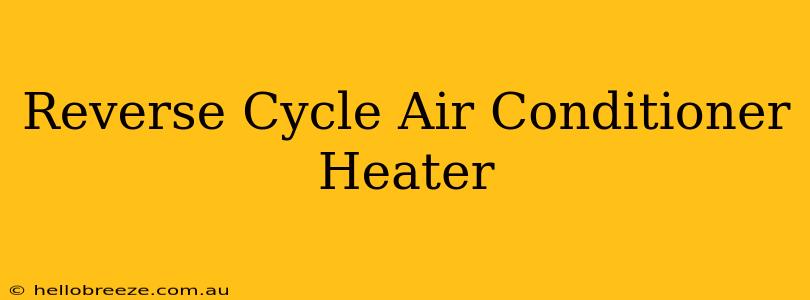Are you tired of juggling separate heating and cooling systems? A reverse cycle air conditioner heater offers a sleek, efficient, and cost-effective solution for year-round climate control. This comprehensive guide will explore the benefits, features, and considerations of choosing a reverse cycle air conditioner heater for your home.
Understanding Reverse Cycle Technology
Reverse cycle air conditioners, also known as heat pumps, utilize a clever thermodynamic process. In cooling mode, they extract heat from your home and release it outside. When you switch to heating mode, the process reverses. The unit draws heat from the outside air, even on cold days, and transfers it inside, providing warmth. This makes them a highly energy-efficient choice compared to traditional electric heaters.
Key Advantages of a Reverse Cycle Air Conditioner Heater:
- Energy Efficiency: Reverse cycle systems are significantly more energy-efficient than electric resistance heaters. They consume less electricity to produce the same amount of heat, leading to lower energy bills.
- Year-Round Comfort: One unit handles both heating and cooling, eliminating the need for two separate systems. This simplifies your climate control and saves space.
- Improved Air Quality: Many reverse cycle models include features like air filtration, improving indoor air quality and reducing allergens.
- Quiet Operation: Modern reverse cycle units are designed for quieter operation, ensuring a peaceful home environment.
- Environmentally Friendly: Their higher energy efficiency reduces your carbon footprint, making them a more environmentally conscious choice.
- Space Saving: A single unit performs the functions of both a heater and an air conditioner, saving valuable space.
Choosing the Right Reverse Cycle Air Conditioner Heater
Selecting the appropriate unit depends on several factors:
1. Size and Capacity:
The heating and cooling capacity (BTU/h or kW) needs to match the size of your space. An undersized unit will struggle to heat or cool effectively, while an oversized unit will cycle on and off frequently, reducing efficiency. Professional assessment is crucial for accurate sizing.
2. Energy Efficiency Rating:
Look for a high energy efficiency ratio (EER) for cooling and a high coefficient of performance (COP) for heating. These ratings indicate how efficiently the unit converts energy into heating and cooling. Higher ratings mean lower energy bills.
3. Features and Functionality:
Consider features like:
- Zoned Control: Allows for individual temperature control in different areas of your home.
- Smart Home Integration: Enables remote control and scheduling through a smartphone app.
- Air Purification: Filters out dust, pollen, and other allergens.
- Quiet Operation: Look for models with low noise levels.
4. Installation:
Professional installation is vital for optimal performance and safety. A qualified technician will ensure proper sizing, placement, and connections.
Maintaining Your Reverse Cycle Air Conditioner Heater
Regular maintenance extends the lifespan and efficiency of your unit. Consider:
- Annual Servicing: Professional servicing ensures optimal performance and identifies potential problems early.
- Filter Cleaning: Regularly clean or replace air filters to maintain airflow and efficiency.
Reverse Cycle Air Conditioner Heater vs. Traditional Systems
| Feature | Reverse Cycle Air Conditioner Heater | Traditional Heating/Cooling Systems |
|---|---|---|
| Efficiency | High | Lower |
| Cost | Higher initial cost, lower running costs | Lower initial cost, higher running costs |
| Space | Space-saving | Requires separate units |
| Maintenance | Moderate | Moderate |
| Environmental Impact | Lower | Higher |
Choosing a reverse cycle air conditioner heater is a significant investment in your home's comfort and energy efficiency. By understanding the technology, selecting the right unit, and maintaining it properly, you can enjoy year-round climate control and significant savings on your energy bills.

